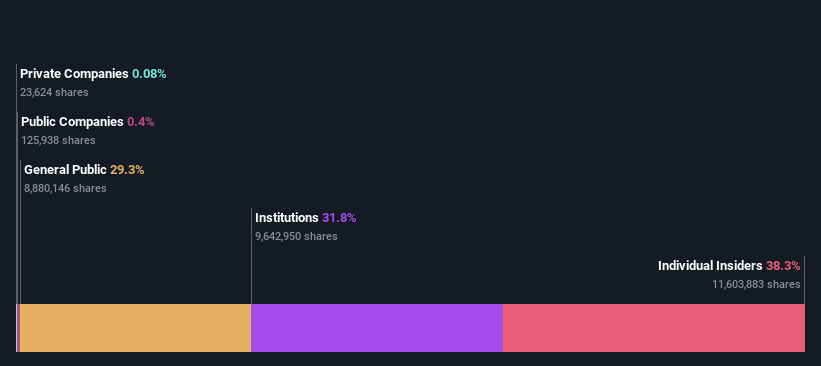Mold-Tek Packaging Limited (NSE:MOLDTKPAC) CEO Lakshmana Janumahanti's holdings dropped 13% in value as a result of the recent pullback
Every investor in Mold-Tek Packaging Limited (NSE:MOLDTKPAC) should be aware of the most powerful shareholder groups. With 38% stake, individual insiders possess the maximum shares in the company. In other words, the group stands to gain the most (or lose the most) from their investment into the company.
As market cap fell to ₹22b last week, insiders would have faced the highest losses than any other shareholder groups of the company.
Let's take a closer look to see what the different types of shareholders can tell us about Mold-Tek Packaging.
View our latest analysis for Mold-Tek Packaging

What Does The Institutional Ownership Tell Us About Mold-Tek Packaging?
Many institutions measure their performance against an index that approximates the local market. So they usually pay more attention to companies that are included in major indices.
We can see that Mold-Tek Packaging does have institutional investors; and they hold a good portion of the company's stock. This implies the analysts working for those institutions have looked at the stock and they like it. But just like anyone else, they could be wrong. It is not uncommon to see a big share price drop if two large institutional investors try to sell out of a stock at the same time. So it is worth checking the past earnings trajectory of Mold-Tek Packaging, (below). Of course, keep in mind that there are other factors to consider, too.

Mold-Tek Packaging is not owned by hedge funds. With a 8.7% stake, CEO Lakshmana Janumahanti is the largest shareholder. DSP Investment Managers Pvt. Ltd. is the second largest shareholder owning 6.5% of common stock, and Adivishnu Subramanyam holds about 5.9% of the company stock. Interestingly, the third-largest shareholder, Adivishnu Subramanyam is also a Member of the Board of Directors, again, indicating strong insider ownership amongst the company's top shareholders.
After doing some more digging, we found that the top 12 have the combined ownership of 51% in the company, suggesting that no single shareholder has significant control over the company.
While studying institutional ownership for a company can add value to your research, it is also a good practice to research analyst recommendations to get a deeper understand of a stock's expected performance. There are a reasonable number of analysts covering the stock, so it might be useful to find out their aggregate view on the future.
Insider Ownership Of Mold-Tek Packaging
While the precise definition of an insider can be subjective, almost everyone considers board members to be insiders. The company management answer to the board and the latter should represent the interests of shareholders. Notably, sometimes top-level managers are on the board themselves.
I generally consider insider ownership to be a good thing. However, on some occasions it makes it more difficult for other shareholders to hold the board accountable for decisions.
It seems insiders own a significant proportion of Mold-Tek Packaging Limited. Insiders own ₹8.3b worth of shares in the ₹22b company. It is great to see insiders so invested in the business. It might be worth checking if those insiders have been buying recently.
General Public Ownership
The general public, who are usually individual investors, hold a 29% stake in Mold-Tek Packaging. This size of ownership, while considerable, may not be enough to change company policy if the decision is not in sync with other large shareholders.
Next Steps:
It's always worth thinking about the different groups who own shares in a company. But to understand Mold-Tek Packaging better, we need to consider many other factors. Consider risks, for instance. Every company has them, and we've spotted 2 warning signs for Mold-Tek Packaging you should know about.
If you are like me, you may want to think about whether this company will grow or shrink. Luckily, you can check this free report showing analyst forecasts for its future.
NB: Figures in this article are calculated using data from the last twelve months, which refer to the 12-month period ending on the last date of the month the financial statement is dated. This may not be consistent with full year annual report figures.
New: Manage All Your Stock Portfolios in One Place
We've created the ultimate portfolio companion for stock investors, and it's free.
• Connect an unlimited number of Portfolios and see your total in one currency
• Be alerted to new Warning Signs or Risks via email or mobile
• Track the Fair Value of your stocks
Have feedback on this article? Concerned about the content? Get in touch with us directly. Alternatively, email editorial-team (at) simplywallst.com.
This article by Simply Wall St is general in nature. We provide commentary based on historical data and analyst forecasts only using an unbiased methodology and our articles are not intended to be financial advice. It does not constitute a recommendation to buy or sell any stock, and does not take account of your objectives, or your financial situation. We aim to bring you long-term focused analysis driven by fundamental data. Note that our analysis may not factor in the latest price-sensitive company announcements or qualitative material. Simply Wall St has no position in any stocks mentioned.
About NSEI:MOLDTKPAC
Mold-Tek Packaging
Engages in the manufacture and sale of plastic packaging containers in India.
Flawless balance sheet with reasonable growth potential.
Similar Companies
Market Insights
Community Narratives



